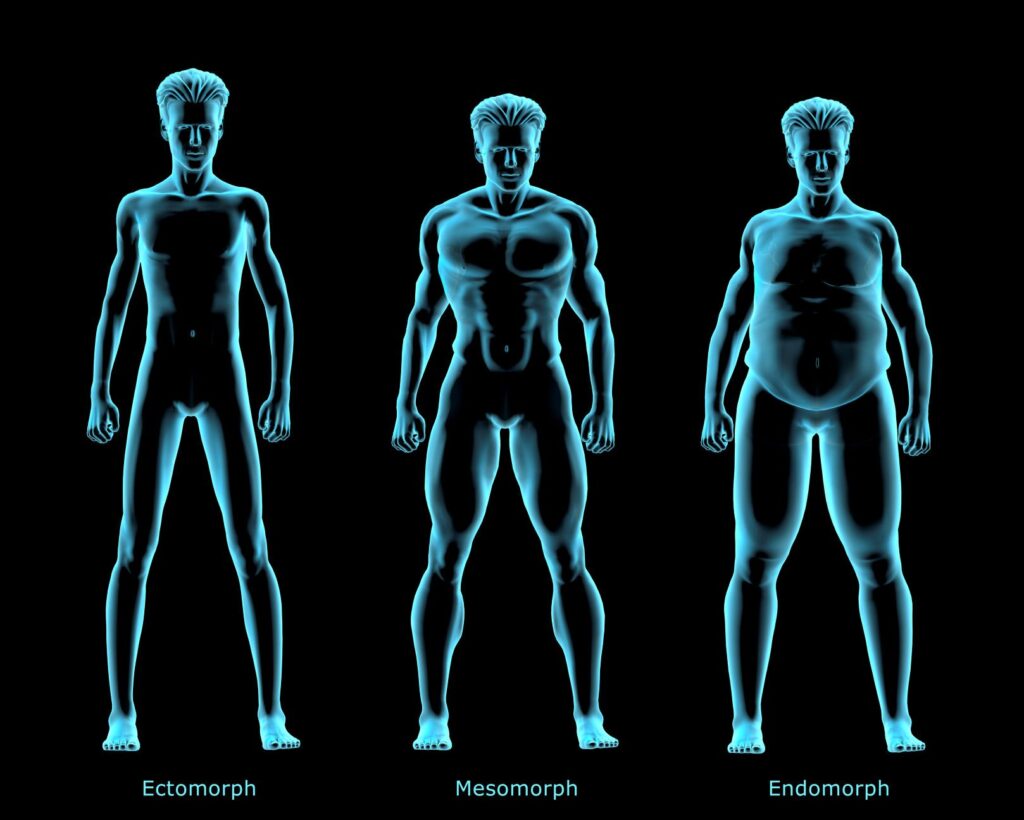
In the 1940s an American psychologist, William Herbert Sheldon, developed a system to categorize human physiques into three distinct types called Somatotypes:
- Ectomorphs – thin individuals, characterized by smaller bone structures, and typically thinner limbs (think endurance athletes).
- Mesomorphs – individuals characterized by a medium sized bone structure and athletic bodies holding a significant amount of lean mass (think gymnasts).
- Endomorphs – individuals characterized by a larger bone structure with higher amounts of total body mass and fat mass (think power lifters).

I like to explain this model of understanding physiques to my clients for a couple of reasons:
- Nutrition protocols – This model of categorizing physiques can be used as a starting point for finding ideal macro-nutrient levels (Carbs/Fats/Protein). Each type will generally thrive on different ratios of these. See my article on the Personalised Plan from the 12 Point Plan where I mention this.
- Having a realistic expectation of what type of body you might achieve if Aesthetics are a main driver for your goals. This reason is what I’m going to expand on here.
The fitness industry has been guilty of selling unrealistic body transformations for decades. Fitness magazines put fitness models on their front covers and sell their magazines based on the idea that, if you follow this 12 Week programme you’ll look like this. Also, Fitness Coaches who have never held excess fat in their life, might tell their clients that if they just eat and train the way they, they’ll end up looking like them. All this is simply untrue.
I should say that the idea of Somatotype has no grounding in biology/genetics. It’s more a model to group people of similar characteristics. However, the DNA you’re born with will largely dictate:
- Your Frame – your skeleton, whilst you can improve bone density, will not significantly change shape due to your training. If you have wider hips and narrower shoulders, you can add some muscle (see below), but you won’t change the shape of your frame.
- Fat Tissue – the amount and type of fat cells in your body and therefore your propensity to store bodyfat
- Muscle Fibre Types – the ratios of slow twitch to fast twitch muscle fibres and therefore how much you’re likely to build muscle mass.
The science of epi-genetics is now showing that your behaviours and environment can cause changes to how your genes work (you can effectively switch genes on or off), so some changes to the areas above can occur. However, it’s still worth knowing that everyone is genetically different.
Here’s my working model:

The triangle above shows each type in a corner. These would be the extreme expressions of each somatotype. I believe you then have a circle within that triangle, such as the one I’ve put in there. That circle shows the ranges of muscle mass and body fat that you can move between.
Your training, diet and lifestyle can move you around within that circle, but the reality is no matter what you do, you won’t be able to move the circle. To give examples of this; Mo Farah (Ectomorph) was never going to make a great 100m sprinter (Mesomorphs). Likewise, Eddie Hall (Endomorph) would never have ran a great marathon time (Ectomorph) or even been a top bodybuilder (despite holding a good amount of muscle, his frame is not the V-shape of a true Mesomorph).
Also, the circle will be biggest at birth, but over time that circle will get smaller depending on your exercise, diet and lifestyle factors throughout your life. If you’re active enough and eat the right diet when as you grow up, you can realise your genetic potential, but over time that diminishes.
I think it’s worth having a rough idea of where your circle is on the triangle if you have aesthetic goals, so you might find an image of someone who is your body type that you aspire too. If you can embrace what you’ve been born with and decide to make the most of it, you’re saving yourself from potential frustration and setting yourself up for a successful journey from the start.